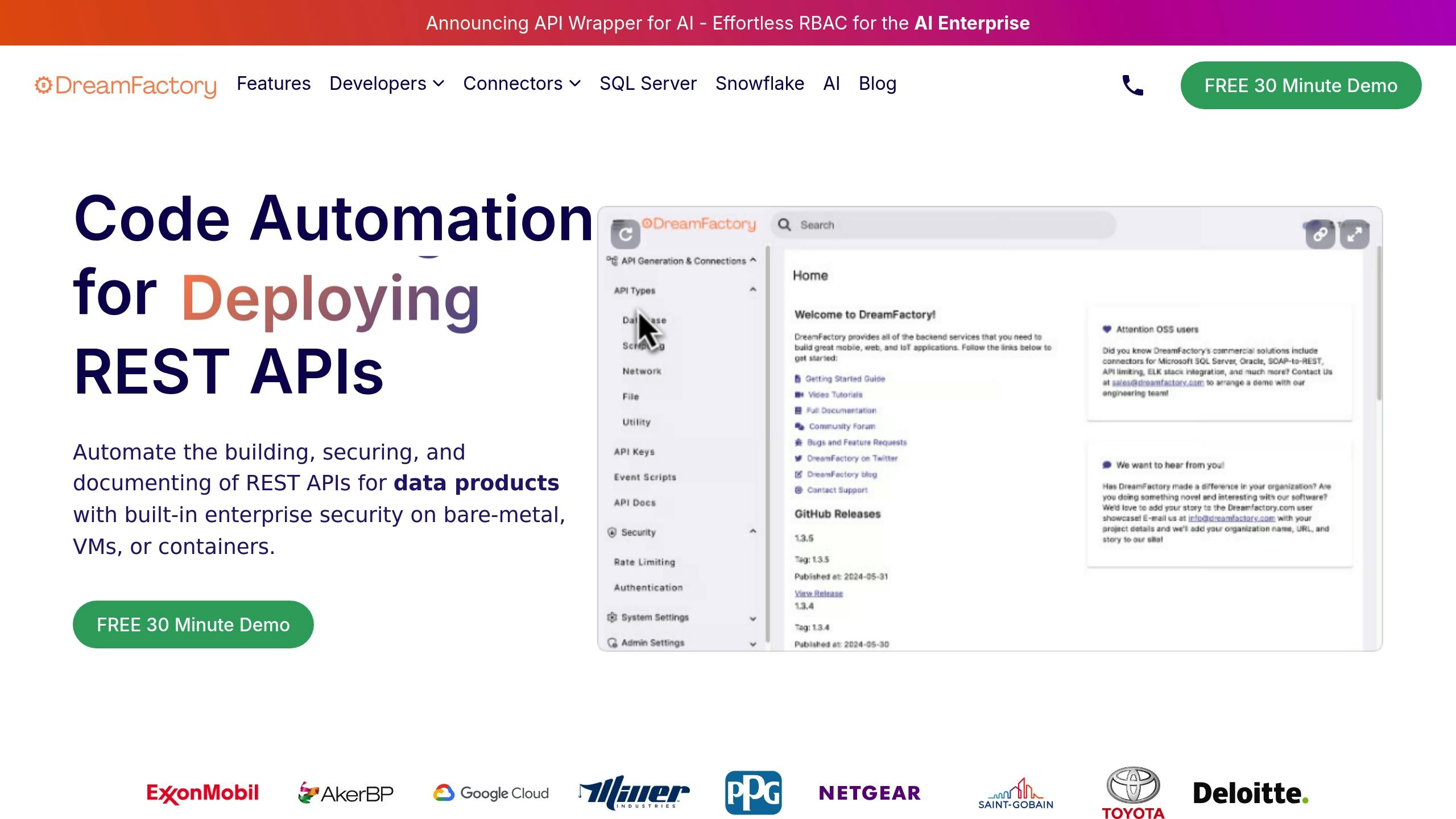Did you know that over 75% of cybersecurity incidents now involve APIs? Protecting data in transit is no longer optional - it’s a must. Here’s how encryption safeguards your API communications and why it’s critical for your business:
Encryption Basics: Encryption converts readable data into an unreadable format during transmission. TLS (Transport Layer Security) is the gold standard, ensuring confidentiality, integrity, and authentication.
Why It Matters: APIs are prime targets for attacks. Without encryption, sensitive data like financial transactions or personal details can be intercepted, leading to breaches costing millions.
Key Encryption Methods:
- Symmetric Encryption: Fast and efficient but requires secure key sharing (e.g., AES-256).
- Asymmetric Encryption: Uses public/private keys for secure exchanges but is slower (e.g., RSA).
- Hybrid Encryption: Combines both for optimal security and performance (used in TLS).
Best Practices: Always use HTTPS, enforce TLS 1.3 or newer, manage API keys securely, and monitor for anomalies.
Encryption isn’t just about meeting compliance standards like GDPR or HIPAA - it’s about protecting your business and customers. Start securing your APIs today to stay ahead of evolving threats.
How to ACTUALLY Secure Your API (5 Steps)
Main Encryption Protocols for API Security
When it comes to safeguarding APIs against evolving threats, encryption protocols are a cornerstone of secure communication. Understanding these protocols can help you make informed decisions to protect data in transit.
Transport Layer Security (TLS)
TLS is widely regarded as the standard for securing API communications. It creates an encrypted channel between clients and servers, ensuring that sensitive information remains private as it moves across public networks.
As explained by the SSL Support Team at SSL.com:
"SSL (Secure Sockets Layer) and its successor, TLS (Transport Layer Security), are security protocols that establish an encrypted link between a client (like your web browser) and a server (the website you are connecting to). This allows for secure transmission of data."
TLS offers three critical protections for API communications:
- Confidentiality: Encrypts all exchanged data, making intercepted information unreadable.
- Data Integrity: Uses message authentication codes (MAC) to detect and prevent tampering.
- Authentication: Verifies the server's identity to ensure communication with the intended party.
As of February 2021, TLS adoption has been impressive: 99.3% of surveyed websites support TLS 1.2, and 42.9% have moved to the newer TLS 1.3. This widespread adoption underscores TLS's reliability and security compared to its predecessor, SSL.
SSL vs. TLS Differences
While SSL and TLS are often mentioned together, they represent different generations of encryption technology. SSL, once the go-to protocol for secure communications, is now outdated due to its reliance on weaker encryption methods like RC4 and MD5. TLS, on the other hand, employs modern algorithms such as AES and ChaCha20, offering stronger protection against brute-force attacks.
TLS also brings advancements in authentication and message verification. It uses HMAC (Hash-based Message Authentication Code), which is far more secure than the basic MAC used in SSL. Additionally, SSL's development ceased years ago, and all versions have been deprecated, while TLS continues to evolve with robust versions like TLS 1.2 and TLS 1.3.
|
Feature |
SSL |
TLS |
|---|---|---|
|
Encryption Algorithms |
RC4, MD5 (weak) |
AES, ChaCha20 (strong) |
|
Message Authentication |
Basic MAC |
HMAC (more secure) |
|
Handshake Efficiency |
Multiple round trips (4–7) |
Reduced round trips (1–2 in TLS 1.3) |
|
Current Status |
Deprecated (2015) |
Active and improving |
|
Perfect Forward Secrecy |
Optional |
Mandatory in TLS 1.3 |
These distinctions make it clear why modern APIs exclusively rely on TLS for secure communications.
How the SSL/TLS Handshake Works
The SSL/TLS handshake is a quick and effective process that establishes a secure connection, often completing in just milliseconds. This handshake is the backbone of secure API interactions, enabling both parties to authenticate each other, agree on encryption protocols, and exchange session keys securely.
Here’s a simplified breakdown of the handshake process:
Client Hello: The client sends a list of supported TLS versions, cipher suites, and a random value called the "client random".
Server Response: The server replies with its SSL certificate, chosen cipher suite, and a "server random".
Certificate Verification: The client verifies the server's SSL certificate with the certificate authority.
Key Exchange: The client generates a "premaster secret", encrypts it using the server’s public key, and sends it to the server.
Session Key Generation: Both parties use the client random, server random, and premaster secret to independently create identical session keys.
Handshake Completion: Both sides exchange "finished" messages encrypted with the session keys.
This process uses asymmetric encryption to securely share the session key, which is then used for faster symmetric encryption during data transfer. With TLS 1.3, perfect forward secrecy ensures that even if one session’s keys are compromised, other sessions remain protected.
Encryption Methods and Algorithms for APIs
When securing API communication, selecting the right encryption method is all about striking the perfect balance between security and performance. While TLS provides a secure channel for data transmission, encryption algorithms safeguard the actual data payload during API interactions.
Symmetric vs. Asymmetric Encryption
The choice between symmetric and asymmetric encryption shapes both the security and efficiency of your API. These two approaches differ significantly in their design and application.
Symmetric encryption relies on a single secret key for both encrypting and decrypting data. Its speed makes it ideal for high-volume tasks, but it comes with the challenge of securely sharing the key. As Michael Cobb explains:
"Symmetric encryption is faster to run because it only uses a single secret key and is based on less complicated mathematics."
The Advanced Encryption Standard (AES), particularly AES-256, is the gold standard for symmetric encryption today. Its efficiency makes it a go-to choice for transferring large amounts of data in APIs, where speed and resource optimization are critical.
On the other hand, asymmetric encryption solves the key-sharing problem by using a pair of keys: a public key for encryption and a private key for decryption. While it provides stronger security for tasks like key exchange and digital signatures, it is slower and more resource-intensive. Nikita Gupta highlights this advantage:
"Asymmetric Encryption has two keys, one public and one private, so there's no problem with distributing keys."
|
Feature |
Symmetric Encryption |
Asymmetric Encryption |
|---|---|---|
|
Number of Keys |
Single key for both operations |
Two keys (public/private pair) |
|
Speed |
Fast |
Slower |
|
Security |
Less secure for key exchange |
Safer for key distribution |
|
Key Distribution |
Requires a secure channel |
Private key stays undisclosed |
|
Common Algorithms |
AES, DES, 3DES |
RSA, ECC, Diffie-Hellman |
|
Resource Usage |
Low |
High |
The most effective approach for API security is hybrid encryption. This combines the strengths of both methods: asymmetric encryption for secure key exchange and symmetric encryption for efficient data transfer. This technique is widely used in protocols like TLS/SSL.
JSON Web Tokens (JWT) and HMAC
JSON Web Tokens (JWT) are a popular choice for stateless API authentication. Defined by RFC 7519, JWTs allow secure information exchange in a compact, self-contained format.
JWTs are especially useful in distributed systems and microservices because they eliminate the need for server-side session storage. The token itself contains all the data required to verify user identity and permissions. To secure JWTs, you can either use HMAC or public/private key pairs. HMAC relies on a shared secret, while algorithms like RSA or ECDSA use key pairs.
HMAC (Hash-based Message Authentication Code) is another powerful tool for ensuring message integrity. By combining a secret key with the message and hashing it (e.g., using SHA-256), HMAC produces a unique signature that guarantees the message hasn’t been altered and comes from a trusted source.
Here’s a quick comparison of JWT and HMAC:
|
Feature |
HMAC |
JWT |
|---|---|---|
|
Primary Purpose |
Verify message integrity |
Represent claims for identity/auth |
|
Token Format |
Raw hash |
JSON-based, Base64 encoded |
|
Stateless Auth |
No |
Yes |
|
Readable Payload |
No |
Yes |
|
Common Use Cases |
API request signing, webhooks |
OAuth2, SSO, mobile authentication |
|
Flexibility |
Low |
High (claims, expiry, scopes, etc.) |
HMAC is perfect for tasks like validating webhooks or signing API requests, where you need verification without exposing the data. JWTs, on the other hand, shine in stateless authentication scenarios where user claims and permissions need to be portable and easily readable.
That said, JWTs are only as secure as their implementation. As Curity points out:
"JWTs are not secure just because they are JWTs, it's the way in which they're used that determines whether they are secure or not."
How to Choose the Right Encryption Method
Choosing the right encryption method comes down to evaluating your API’s performance needs, security level, and system design.
Performance: Symmetric encryption is the fastest option, making it ideal for APIs handling high volumes of data or requiring low latency. Algorithms like AES are particularly well-suited for these scenarios.
Security: For sensitive data or secure key exchanges, asymmetric encryption provides stronger protection. Its computational complexity makes it harder to break, although it’s slower.
System Architecture: In closed systems where keys can be securely shared, symmetric encryption works well. For open, internet-based systems, asymmetric encryption is essential for establishing secure communication channels.
A hybrid approach often delivers the best of both worlds. By using asymmetric encryption for the initial handshake and key exchange, and then switching to symmetric encryption for bulk data transfer, you can achieve both security and speed. This is the same strategy employed by TLS/SSL protocols.
For JWTs, opt for robust signing algorithms like RS256 over weaker options like HS256, especially in distributed environments. Ensure token integrity by validating claims, setting expiration times, and avoiding sensitive data in the payload.
Finally, stay updated with cryptographic standards. For instance, NIST deprecated DES in 2017 and has called for the full phase-out of 3DES by 2023. Keeping up with these changes ensures your encryption strategy remains effective against emerging threats.
Best Practices for Securing Data in Transit
Protecting API data as it moves between systems is a cornerstone of modern security. With 90% of web traffic involving APIs, safeguarding these channels is essential to defend against increasingly sophisticated threats.
Always Use HTTPS
The first step to securing data in transit is adopting HTTPS. This protocol encrypts all communication between clients and servers, making intercepted data unreadable. From login credentials to sensitive business information, HTTPS ensures everything stays protected. Simply put, HTTPS is non-negotiable for modern API security.
"We're certainly in the early days of this emerging API security space, but in thinking about API security going forward, it's going to become the very foundation for modern applications." - Tyler Reynolds, Senior Solution Architect at Kong
For optimal security, TLS 1.3 or newer is recommended. Pair this with strong cipher suites to enhance encryption. Adding HTTP Strict Transport Security (HSTS) forces browsers and applications to use HTTPS exclusively, protecting against downgrade attacks. For highly sensitive APIs, consider using mutual TLS (mTLS) and certificate pinning to further lock down communications.
Certificate Management and Protocol Updates
Certificate management plays a key role in verifying server identities through trusted Certificate Authorities. To ensure past communications remain secure, implement Perfect Forward Secrecy, which generates unique session keys for every connection.
Keep your security protocols current. Outdated standards like SSL 3.0 and TLS 1.0 are vulnerable and should be disabled. Regular updates help guard against emerging threats. Additionally, using transparency logs can detect unauthorized certificates issued for your domains, providing an extra layer of protection.
API Key and Token Security
Encryption alone isn’t enough - managing API keys and tokens is equally crucial. Think of API keys as passwords and handle them with the same level of care. A breach in December 2024 involving the US Department of the Treasury underscores the risks. Hackers exploited a compromised API key from BeyondTrust to reset passwords across government systems.
Here’s how to secure your API keys:
- Generate strong, unique keys with complex strings of numbers, upper and lowercase letters, and special characters. Avoid predictable patterns.
- Store keys securely in environment variables or secret management tools.
- Rotate keys regularly to limit exposure if one is compromised.
- Use granular permissions to restrict each key’s access to only what’s necessary.
- Monitor usage in real time to detect anomalies and enforce rate limiting to prevent abuse.
- Have a system for immediate revocation to disable compromised keys instantly.
For JWT tokens, validate every component, including signature algorithms and claims, to ensure security. Avoid weak algorithms and treat tokens with the same caution as passwords. Never store JWTs in client-side code where they could be exposed.
Lastly, team training is critical. Regular education and clear documentation ensure everyone handling API keys understands the risks and follows proper security practices.
Automated API Encryption with DreamFactory

DreamFactory takes the hassle out of securing data in transit by automating encryption processes, making API security faster and more efficient. Instead of spending months on manual encryption, DreamFactory lets you create secure APIs in just minutes.
Automated Secure REST API Generation
Forget the headaches of manual API development. DreamFactory simplifies the process by instantly generating secure REST API endpoints for any table, view, or stored procedure - no coding required. What used to take thousands of lines of code now happens in moments.
The platform automatically maps database schemas to secure REST endpoints, using HTTPS/TLS encryption and automated key management. Built-in SSL/TLS encryption and automated key handling ensure your APIs are secure right from the start.
"DreamFactory streamlines everything and makes it easy to concentrate on building your front end application. I had found something that just click, click, click... connect, and you are good to go."
- Edo Williams, Lead Software Engineer, IntelBy using DreamFactory, organizations can c t build times by up to 85%. For example, a major energy company used DreamFactory to create a secure data access layer for Snowflake "gold datasets" across its enterprise. What would normally take months was completed in just days.
And encryption is just the start - DreamFactory also strengthens API security with advanced access controls.
Role-Based Access Controls and Logging
Secure APIs need more than encryption; they require strict access management and detailed logging. DreamFactory’s role-based access control (RBAC) limits user access to specific database components through precise HTTP permissions. This ensures each API key operates under the principle of least privilege.
In addition, the platform’s comprehensive logging tracks every interaction. This has helped organizations reduce common security risks by 99% and unauthorized access attempts by 94%. DreamFactory also supports federated access and data governance, helping businesses stay compliant with regulations like GDPR and HIPAA. Using the ELK stack, the platform provides detailed reporting on API traffic, giving teams the visibility they need to reduce data breach risks by up to 70% and improve compliance by 90%.
DreamFactory also employs AES-256 encryption to securely store credentials. Its defense-in-depth strategy includes individually generated access keys for each API, rate limiting, and real-time traffic monitoring through tools like Elasticsearch, Logstash, Kibana, or Grafana dashboards.
Database Integration with Encryption Standards
When working with diverse databases, maintaining consistent encryption standards is crucial. DreamFactory supports over 20 database connectors - including Snowflake, SQL Server, and MongoDB - while ensuring encryption is applied uniformly across all integrations.
The platform enhances the security of connected SQL databases by encrypting master credentials and securely proxying external data sources. This means sensitive credentials are never exposed, even when connecting to multiple data sources. Encryption standards are strictly enforced, keeping data transmission secure.
In one example, a U.S.-based energy company used DreamFactory to create REST APIs on Snowflake, overcoming integration challenges that had stalled critical data insights. By connecting various data sources for predictive analytics and operational AI models, the company slashed months of custom development work, achieving an 85% reduction in build time and speeding up AI analytics deployment.
"DreamFactory is far easier to use than our previous API management provider, and significantly less expensive."
- Adam Dunn, Sr. Director, Global Identity Development & Engineering, McKesson
DreamFactory also incorporates Cross-Origin Resource Sharing (CORS) as a system-level web service and protects against all OWASP Top 10 web application security risks using industry-standard controls.
Conclusion: Securing API Data in Transit
Protecting API data in transit is a non-negotiable step in safeguarding sensitive information and maintaining trust. With industry experts forecasting that API attacks could dominate by the end of 2024, and over 75% of cybersecurity professionals already reporting incidents, the urgency to act is clear.
To ensure secure data transmission, it's crucial to use HTTPS with TLS 1.2 or higher and implement robust encryption protocols like AES-256, along with regular certificate rotations. These measures not only help meet regulatory requirements but also serve as the foundation for secure communication.
"Encryption is a foundational security measure designed to protect data integrity and confidentiality." - Vartul Goyal, Author
That said, encryption is just one piece of the puzzle. Comprehensive API security demands a multi-layered approach, including role-based access controls, secure authentication mechanisms, and continuous monitoring. The December 2024 BeyondTrust breach - where Chinese state-backed hackers exploited a compromised API key to access U.S. government workstations - highlights how even a single vulnerability can lead to catastrophic consequences.
To address these challenges, streamlined solutions are essential. Automated platforms like DreamFactory combine encryption with built-in security features, simplifying implementation while improving efficiency. With nearly 50% of B2B interactions now conducted via API requests, automation has become a critical component in balancing security with operational demands.
The path forward is clear: adopt strong encryption standards, follow proven best practices, and leverage automation to bolster your defenses. Protecting data in transit isn’t just a technical requirement - it’s a necessity for resilience in today’s API-driven world.
FAQs
What is the difference between TLS and SSL, and why is TLS the better choice for securing APIs?
TLS, or Transport Layer Security, is essentially the upgraded and more secure successor to SSL (Secure Sockets Layer). It brings better encryption, enhanced authentication, and a quicker handshake process, which translates to more efficient and secure connections. TLS was developed to fix the weaknesses found in SSL, which is now outdated and no longer reliable for safeguarding sensitive information.
In modern API security, TLS plays a critical role. It supports advanced cryptographic protocols and adheres to the latest internet security standards. By implementing TLS, you can ensure that data transmitted over public networks is well-protected, shielding it from interception or tampering during transit.
What is hybrid encryption, and how does it improve API security?
Hybrid encryption brings together the best of symmetric encryption and asymmetric encryption to bolster API security. Symmetric encryption methods, like AES, are employed for fast data encryption, while asymmetric encryption techniques, such as RSA, handle the secure exchange of symmetric keys. This combination ensures that data remains accessible only to authorized users.
By merging the efficiency of symmetric encryption with the secure key-sharing capabilities of asymmetric encryption, hybrid encryption delivers both speed and strong security, making it a reliable choice for safeguarding data sent over public networks.
What are the best practices for securing API keys and tokens to prevent unauthorized access?
To keep your API keys and tokens safe from prying eyes, here are some essential steps to follow:
Create strong, unique keys: Make sure each key is highly random and specific to a single API. Avoid reusing the same key across multiple services.
- Limit access: Use measures like IP address restrictions, referrer rules, or usage limits to control who can use your keys.
- Rotate keys and tokens regularly: Changing them frequently reduces the risk if they get exposed.
- Secure storage: Encrypt your keys and tokens, and never hard-code them into client-side applications or expose them publicly.
For tokens, set short expiration times to reduce their exposure window. Always transmit them securely using HTTPS. Implement OAuth 2.0 or JWT with proper validation to ensure secure authentication. These practices go a long way in safeguarding your API and the sensitive data it handles.
Kevin McGahey is an accomplished solutions engineer and product lead with expertise in API generation, microservices, and legacy system modernization, as demonstrated by his successful track record of facilitating the modernization of legacy databases for numerous public sector organizations.
























 Blog
Blog


